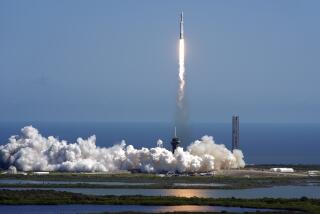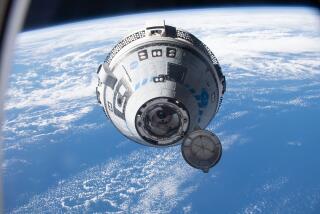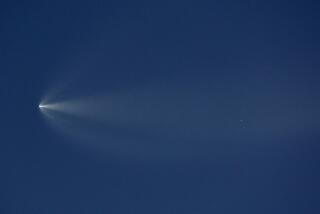Out-Waiting Weather, Atlantis Streaks Aloft
CAPE CANAVERAL, Fla. â The space shuttle Atlantis out-waited fickle weather and streaked into orbit today with just five minutes to spare, carrying five astronauts who will dispatch the Magellan probe to collect the most detailed images ever of cloud-shrouded Venus.
The shuttle thundered smoothly into the Florida sky at 11:47 a.m. PDT after being delayed a nail-biting 59 minutes by shifting rain clouds and winds that had threatened a second postponement in six days. NASA had 64 minutes in which to launch today.
The launch starts a 15-month journey of 806 million miles for the robot explorer craft Magellan, which is named for the 16th-Century Portuguese explorer and marks the first American deep space probe in 11 years. The $550- million craft is carrying to Venus a powerful radar system that will map most of the planet.
Atlantis, riding a 700-foot cascade of flame, rose majestically from its beachside launch pad into a blue, nearly cloudless sky, rolled slowly on its planned path and streaked up and out of view.
Two solid-fueled booster rockets burned out after 2 minutes, 6 seconds, precisely on schedule, and were jettisoned. Atlantis flew on, powered by its liquid-fueled rockets.
The successful launch came despite dark clouds and showers earlier in the day. By late in the launch window, sea breezes had swept the skies and crosswinds were below the permitted 14 m.p.h. at the Kennedy Space Center emergency landing site.
NASAâs first attempt to launch Atlantis last Friday was halted just 31 seconds before liftoff when a flaw was detected in a fuel pump. Later, engineers also found what appeared to be a leak in a hydrogen fuel line. Both parts were replaced.
The crew members for the mission, the 29th shuttle flight and the fourth since the Challenger disaster, are commander David M. Walker, pilot Ronald Grabe, and mission specialists Norman Thagard, Mary Cleave and Mark Lee.
1 1/2 Times Around Sun
Six hours after launch, Cleave and Lee were to operate remote controls to eject Magellan from the shuttleâs cargo bay. A powerful rocket will then send Magellan out of Earth orbit and start it on a 15-month voyage that will carry it 1 1/2 times around the sun before reaching Venus.
Venus has long fascinated astronomers because it is a near-twin of Earth, at least in terms of size and chemical composition. But at some point during the planetâs evolution, it turned into a hellish inferno utterly hostile to life.
The planet now is the apparent victim of a runaway âgreenhouse effectâ in which solar radiation trapped by the planetâs thick carbon dioxide atmosphere produces temperatures of 900 degrees--hot enough to melt lead.
More to Read
Sign up for Essential California
The most important California stories and recommendations in your inbox every morning.
You may occasionally receive promotional content from the Los Angeles Times.










